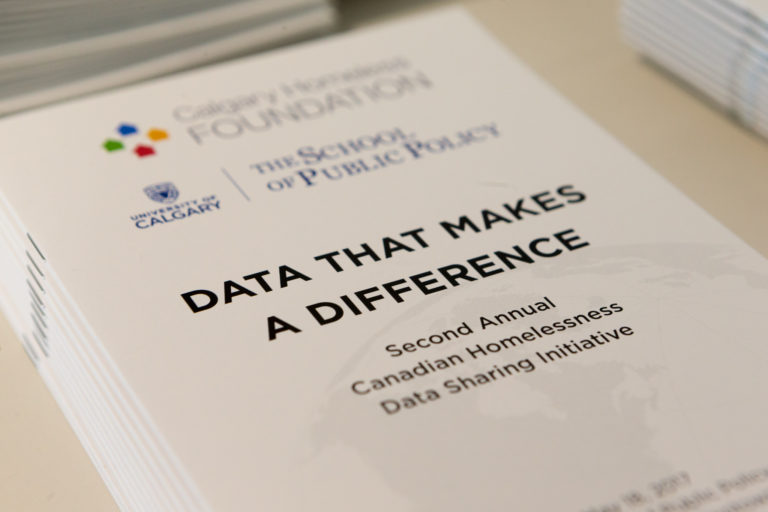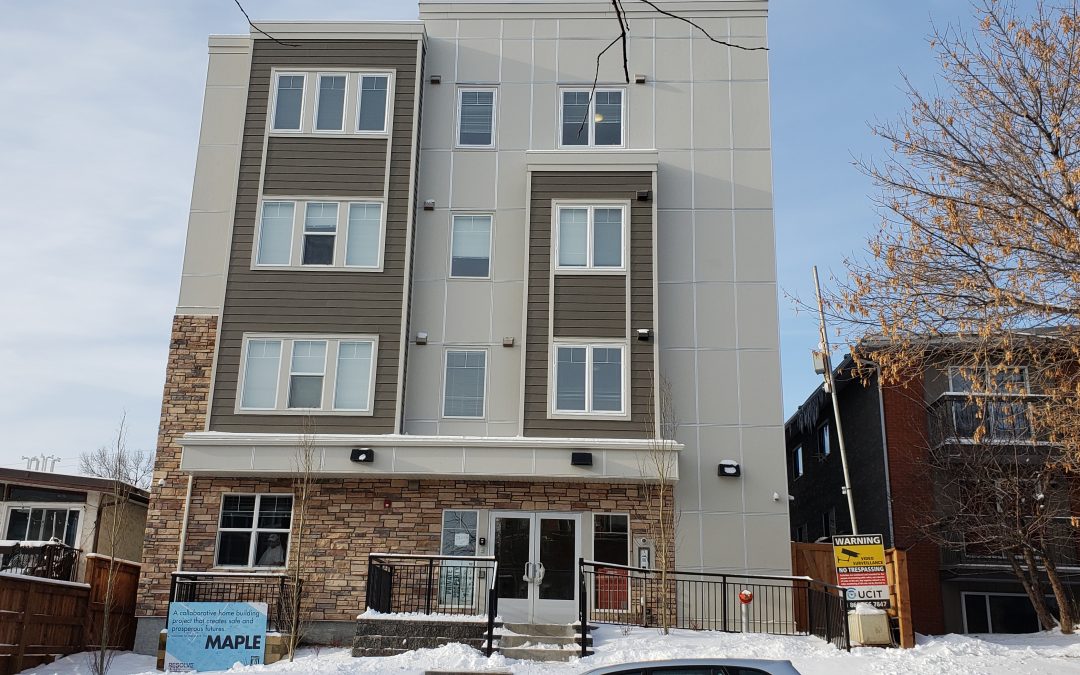
Second Annual Canadian Homelessness Data Sharing Initiative
Second Annual Canadian Homelessness Data Sharing Initiative
On May 18, 2017, the Second Annual Canadian Homelessness Data Sharing Initiative took place in Calgary (all slide presentations, as well as photos from the event, are available here). The event was organized by the Calgary Homeless Foundation and the University of Calgary’s School of Public Policy, and the participants included: people who build datasets (about persons experiencing homelessness); researchers who use that data; persons with lived experience; and public servants.
Here are 10 things to know about this year’s event:
1. For the second year in a row, there was strong representation from Canada’s federal government. Five officials from Employment and Social Development Canada (ESDC) participated, three of whom had formal speaking roles at the event. Aaron Segaert (from ESDC) presented data from more than 200 homeless shelters between 2005 and 2014, showing that:
- the occupancy rate (i.e. % of beds filled each night) across these shelters rose from 83% in 2010 to 92% in 2014;
- the average ‘duration of stay’ by households using these shelters is increasing, especially for families and seniors;
- the number of seniors using homeless shelters annually nearly doubled across Canada between 2005 and 2014.
2. This year’s event had strong Quebec representation. Research presented by Annie Duchesne, for example, finds that certain subgroups of persons in Montreal’s largest homeless shelter are more likely to experience chronic homelessness (i.e. long-term homelessness) than others—those subgroups include persons over the age of 50, persons with mental health problems and persons with disabilities.
3. Indigenous perspectives were presented. Bonnie Healy’s presentation focused on the work of the Alberta First Nations Information Governance Centre. Topics raised in her presentation included First Nations OCAP principles, a publication titled First Nations – Health Trends Alberta, the First Nations health status report for the Alberta region, the work of the Alberta First Nations Governance Centre, and Indigenous logic models.
4. Several data-sharing advocates actively participated in this year’s event. Michael Lenczner, a data-sharing champion in Canada’s social sector, attended and spoke at this year’s event. He stated that, in terms of data sharing, he’s not aware of any other subsector of Canada’s non-profit sector that has an annual forum to discuss the importance of data. He also cited Alberta as a leader in data sharing, making reference mostly to PolicyWise, who’ve worked with government to link client administrative data from multiple ministries. They’re the leaders of this kind of data-linking in Canada, and possibly the world.
5. Difficulties with researchers accessing federal homelessness data were raised. Tracey Lauriault is a Carleton University professor who described her past difficulties in trying to access HIFIS data for research. When she did, she was told that her data requests must be sent to community coordinators; yet, federal officials were never able to provide her with a list of community coordinators.
6. One of the event highlights was a panel discussion on moving towards increased national integration of Homelessness Management Information Systems (HMIS). As I’ve written before, there are multiple software systems across Canada that keep data on persons experiencing homelessness; many people would like to see increased integration of these systems (possibly into one very large system, or at least the sharing of data among these systems so that researchers can have larger samples for their work). Henry Dagher (ESDC) discussed the evolution of the Homeless Individuals and Families Information System (HIFIS) software system (which is one type of HMIS system). This federally-administered HIFIS system is now operating in more than 100 communities. HIFIS 4 is now web-based and gaining strong momentum; BC Housing is now implementing HIFIS province-wide (spanning approximately 200 service providers). Several panel members suggest that community members need to gain more control of HIFIS (via a stakeholder advisory body with some clout that includes persons with lived experience). As Michael Lenczner puts it: “The tail shouldn’t wag the dog.” Jenn Legate (Calgary Homeless Foundation) raised several operational concerns that need to be kept in mind as we move forward on increased national integration of HIMIS systems—namely, the ongoing costs a server, the cost of migrating data from an old database system to a new system, challenges pertaining to customer service provided by software vendors, and legal barriers to data sharing.
7. Important findings were presented from Canada’s recent nationally-coordinated Point in Time Count of homeless persons. Patrick Hunter’s presentation noted that more than 25% of homeless persons enumerated during the 2016 count did not use an emergency shelter during the previous year—I think this speaks in part to conditions in emergency shelters, about which there’s virtually no research.[1] Hunter also reported that Indigenous peoples are nine times more likely to experience homelessness than the rest of Canada’s population; what’s more, more likely to experience longer homeless spells than non-Indigenous people.
8. One of the event highlights was a “review of the day” by Stephen Metraux. Metraux, the Director of the Health Policy Program at the University of the Sciences in Philadelphia, gave a ‘wrap up’ presentation that included a short slide presentation. He subsequently wrote a blog post in which he reflected on his experience at the event.
9. Several suggestions were made about a ‘way forward.’ Topics that need to be tackled in the future include:
- important work being done by Statistics Canada pertaining to data linking;
- work being done by the Canadian Institute for Health Information, where medical data is being consolidated across provinces (i.e., provinces are sharing health care data);
- better national coordination of HMIS systems;
- more data sharing and standards;
- the possibility of developing a repository of data pertaining to homelessness (see point #7 of this previous blog post); and
- the development of a National Data Strategy for Homelessness.
10. This will continue to be an annual event that we expect to be held each year in (or near) Calgary. It may also evolve into a two-day format, with one day focusing on the operational aspects associated with building, maintaining and improving HMIS systems. All of these operational matters are the focus of this biannual event in the United States; yet, no Canadian equivalent currently exists.
In Sum. We hope this annual event will help communities across Canada get closer to ending homelessness. The event web page—with slide presentations and minutes from the event—can be found here.
A blog post written about the First Annual Canadian Homelessness Data Sharing Initiative can be found here.
The author wishes to thank the following individuals for invaluable assistance with this blog post: Vicki Ballance, Ron Kneebone, Eric Latimer, Tracey Lauriault, Kara Layher, Michael Lenczner, Lindsay Lenny, Stephen Metraux and one anonymous source. Any errors lie with the author.
[1] This 2016 report on conditions inside Out of the Cold facilities and Warming Centres is worth reading. However, it should be noted that the facilities that are the focus of this report are not “homeless shelters” as defined by City of Toronto officials; rather, they operate separately from the formal shelter system.
You can view a PDF version of this blog post here: Second Annual Canadian Homelessness Data Sharing Initiative


